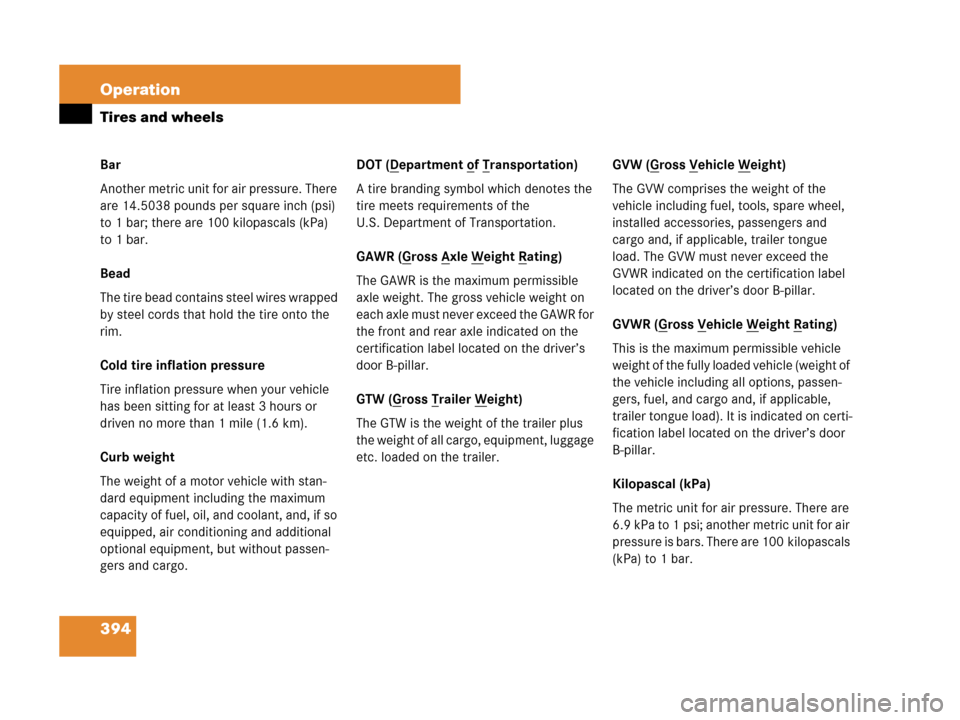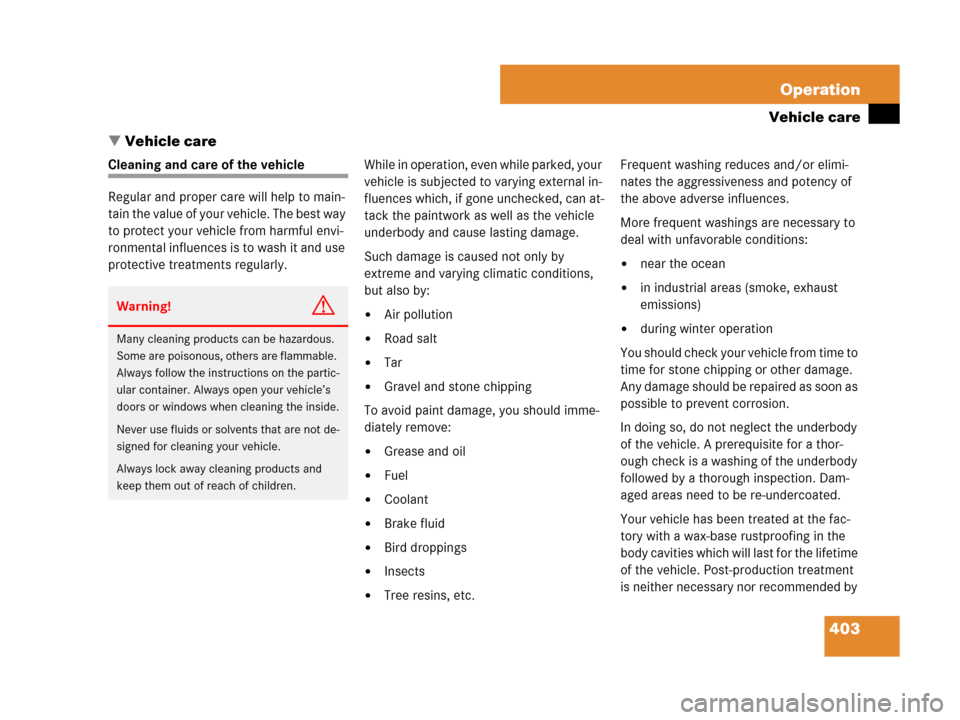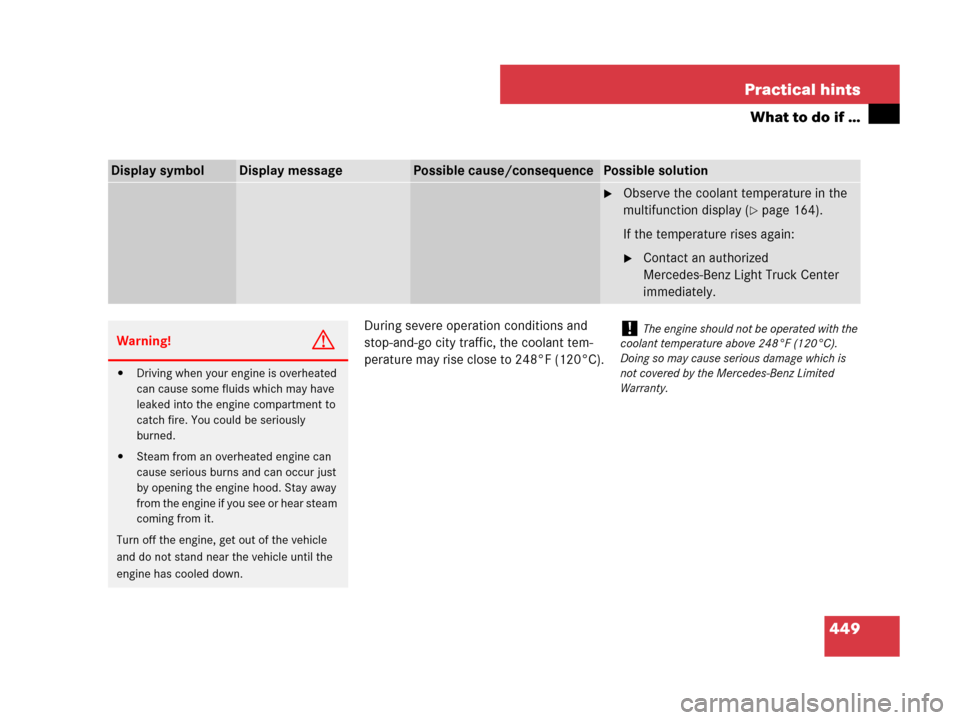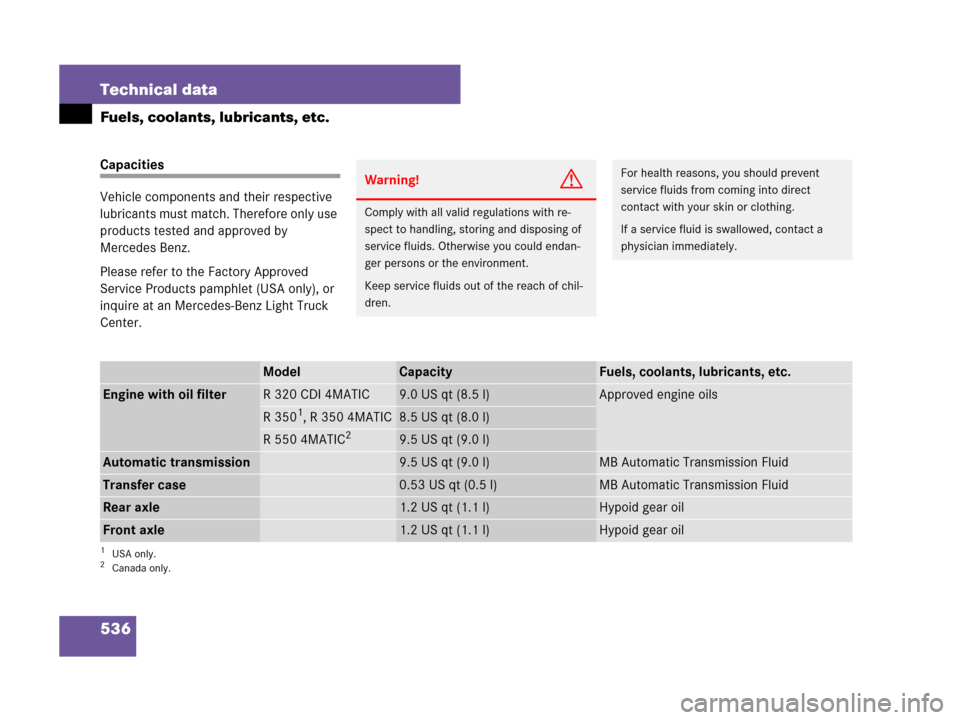Page 395 of 569

394 Operation
Tires and wheels
Bar
Another metric unit for air pressure. There
are 14.5038 pounds per square inch (psi)
to 1 bar; there are 100 kilopascals (kPa)
to 1 bar.
Bead
The tire bead contains steel wires wrapped
by steel cords that hold the tire onto the
rim.
Cold tire inflation pressure
Tire inflation pressure when your vehicle
has been sitting for at least 3 hours or
driven no more than 1 mile (1.6 km).
Curb weight
The weight of a motor vehicle with stan-
dard equipment including the maximum
capacity of fuel, oil, and coolant, and, if so
equipped, air conditioning and additional
optional equipment, but without passen-
gers and cargo.DOT (Department of Transportation)
A tire branding symbol which denotes the
tire meets requirements of the
U.S. Department of Transportation.
GAWR (G
ross Axle Weight Rating)
The GAWR is the maximum permissible
axle weight. The gross vehicle weight on
each axle must never exceed the GAWR for
the front and rear axle indicated on the
certification label located on the driver’s
door B-pillar.
GTW (G
ross Trailer Weight)
The GTW is the weight of the trailer plus
the weight of all cargo, equipment, luggage
etc. loaded on the trailer. GVW (G
ross Vehicle Weight)
The GVW comprises the weight of the
vehicle including fuel, tools, spare wheel,
installed accessories, passengers and
cargo and, if applicable, trailer tongue
load. The GVW must never exceed the
GVWR indicated on the certification label
located on the driver’s door B-pillar.
GVWR (G
ross Vehicle Weight Rating)
This is the maximum permissible vehicle
weight of the fully loaded vehicle (weight of
the vehicle including all options, passen-
gers, fuel, and cargo and, if applicable,
trailer tongue load). It is indicated on certi-
fication label located on the driver’s door
B-pillar.
Kilopascal (kPa)
The metric unit for air pressure. There are
6.9 kPa to 1 psi; another metric unit for air
pressure is bars. There are 100 kilopascals
(kPa) to 1 bar.
Page 404 of 569

403 Operation
Vehicle care
�Vehicle care
Cleaning and care of the vehicle
Regular and proper care will help to main-
tain the value of your vehicle. The best way
to protect your vehicle from harmful envi-
ronmental influences is to wash it and use
protective treatments regularly.While in operation, even while parked, your
vehicle is subjected to varying external in-
fluences which, if gone unchecked, can at-
tack the paintwork as well as the vehicle
underbody and cause lasting damage.
Such damage is caused not only by
extreme and varying climatic conditions,
but also by:
�Air pollution
�Road salt
�Tar
�Gravel and stone chipping
To avoid paint damage, you should imme-
diately remove:
�Grease and oil
�Fuel
�Coolant
�Brake fluid
�Bird droppings
�Insects
�Tree resins, etc.Frequent washing reduces and/or elimi-
nates the aggressiveness and potency of
the above adverse influences.
More frequent washings are necessary to
deal with unfavorable conditions:
�near the ocean
�in industrial areas (smoke, exhaust
emissions)
�during winter operation
You should check your vehicle from time to
time for stone chipping or other damage.
Any damage should be repaired as soon as
possible to prevent corrosion.
In doing so, do not neglect the underbody
of the vehicle. A prerequisite for a thor-
ough check is a washing of the underbody
followed by a thorough inspection. Dam-
aged areas need to be re-undercoated.
Your vehicle has been treated at the fac-
tory with a wax-base rustproofing in the
body cavities which will last for the lifetime
of the vehicle. Post-production treatment
is neither necessary nor recommended by
Warning!G
Many cleaning products can be hazardous.
Some are poisonous, others are flammable.
Always follow the instructions on the partic-
ular container. Always open your vehicle’s
doors or windows when cleaning the inside.
Never use fluids or solvents that are not de-
signed for cleaning your vehicle.
Always lock away cleaning products and
keep them out of reach of children.
Page 449 of 569
448 Practical hints
What to do if …
Display symbolDisplay messagePossible cause/consequencePossible solution
•Coolant Level
Stop car, switch engine off.The coolant is too hot.
Among other possible causes
(the cooling fan could be
malfunctioning), the poly-V-belt
could be broken.�Stop the vehicle in a safe location or
as soon as it is safe to do so.
�Turn off the engine.
�Apply the parking brake (�page 65).
�Check the poly-V-belt.
If it is broken:
�Do not continue to drive. Otherwise
the engine will overheat due to an
inoperative water pump which may
result in damage to the engine.
Contact an authorized
Mercedes-Benz Light Truck Center.
If it is intact:
�Wait for the message to disappear
before restarting the engine.
Doing otherwise could result in seri-
ous engine damage that is not
covered by the Mercedes-Benz
Limited Warranty.
(Continued on next page)
Page 450 of 569

449 Practical hints
What to do if …
During severe operation conditions and
stop-and-go city traffic, the coolant tem-
perature may rise close to 248°F (120°C).
Display symbolDisplay messagePossible cause/consequencePossible solution
�Observe the coolant temperature in the
multifunction display (
�page 164).
If the temperature rises again:
�Contact an authorized
Mercedes-Benz Light Truck Center
immediately.
Warning!G
�Driving when your engine is overheated
can cause some fluids which may have
leaked into the engine compartment to
catch fire. You could be seriously
burned.
�Steam from an overheated engine can
cause serious burns and can occur just
by opening the engine hood. Stay away
from the engine if you see or hear steam
coming from it.
Turn off the engine, get out of the vehicle
and do not stand near the vehicle until the
engine has cooled down.
!The engine should not be operated with the
coolant temperature above 248°F (120°C).
Doing so may cause serious damage which is
not covered by the Mercedes-Benz Limited
Warranty.
Page 451 of 569
450 Practical hints
What to do if …
Display symbolDisplay messagePossible cause/consequencePossible solution
B Top Up Coolant
See Operator’s ManualThe coolant level is too low.�Add coolant (�page 360).
�If you have to add coolant frequently,
have the cooling system checked by an
authorized Mercedes-Benz Light Truck
Center.
Warning!G
Do not spill antifreeze on hot engine parts.
Antifreeze contains ethylene glycol which
may burn if it comes into contact with hot
engine parts. You could be seriously burned.
!Do not ignore the low engine coolant level
warning. Extended driving with the message and
symbol displayed may cause serious engine
damage not covered by the Mercedes-Benz
Limited Warranty.
Do not drive without sufficient amount of coolant
in the cooling system. The engine will overheat,
causing major engine damage.
Page 522 of 569
521 Technical data
Parts service
Warranty coverage
Identification labels
Layout of poly-V-belt drive
Engine
Rims and tires
Electrical system
Main Dimensions
Weights
Fuels, coolants, lubricants, etc.
Page 527 of 569
526 Technical data
Layout of poly-V-belt drive
R 320 CDI 4MATIC
1Coolant pump
2Idler pulley
3Automatic belt tensioner
4Power steering pump
5Air conditioning compressor
6Crankshaft
7Idler pulley
8Generator (alternator)R 350, R 350 4MATIC, R 550 4MATIC
1Idler pulley
2Idler pulley
3Automatic belt tensioner
4Power steering pump
5Air conditioning compressor
6Crankshaft
7Coolant pump
8Generator (alternator)
Page 537 of 569

536 Technical data
Fuels, coolants, lubricants, etc.
Capacities
Vehicle components and their respective
lubricants must match. Therefore only use
products tested and approved by
Mercedes Benz.
Please refer to the Factory Approved
Service Products pamphlet (USA only), or
inquire at an Mercedes-Benz Light Truck
Center.
Warning!G
Comply with all valid regulations with re-
spect to handling, storing and disposing of
service fluids. Otherwise you could endan-
ger persons or the environment.
Keep service fluids out of the reach of chil-
dren.
For health reasons, you should prevent
service fluids from coming into direct
contact with your skin or clothing.
If a service fluid is swallowed, contact a
physician immediately.
ModelCapacityFuels, coolants, lubricants, etc.
Engine with oil filterR 320 CDI 4MATIC9.0 US qt (8.5 l)Approved engine oils
R 3501, R 350 4MATIC
1USA only.
8.5 US qt (8.0 l)
R 550 4MATIC2
2Canada only.
9.5 US qt (9.0 l)
Automatic transmission9.5 US qt (9.0 l)MB Automatic Transmission Fluid
Transfer case0.53 US qt (0.5 l)MB Automatic Transmission Fluid
Rear axle1.2 US qt (1.1 l)Hypoid gear oil
Front axle1.2 US qt (1.1 l)Hypoid gear oil